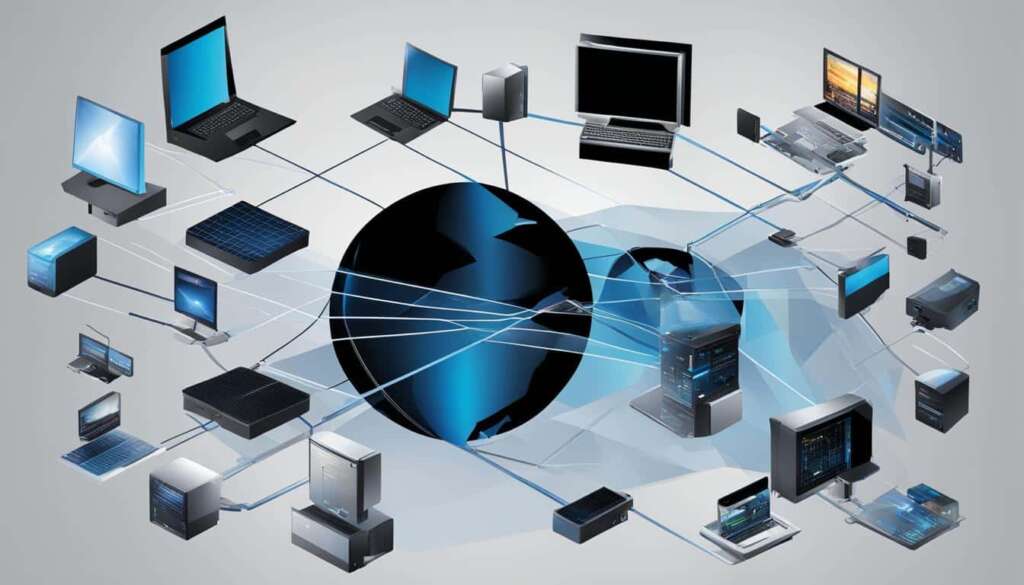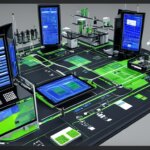Table of Contents
Telecommunications is the exchange of information and signals over long distances. It enables communication between individuals and organizations, facilitating the exchange of voice, data, and multimedia. In today’s connected world, telecommunications plays a critical role in shaping modern society and driving progress.
The components of telecommunications include infrastructure such as cables, satellites, and cell towers. Additionally, the equipment and devices used to transmit and receive information, as well as the role of service providers and regulatory bodies, are crucial elements of the telecommunications system.
In this section, we will explore the definition of telecommunications, its key components, and its significance in our increasingly connected world.
Key Takeaways
- Telecommunications is the transmission of information and signals over long distances.
- It involves infrastructure, equipment, devices, service providers, and regulatory bodies.
- Telecommunications enables communication between individuals and organizations, facilitating the exchange of voice, data, and multimedia.
- Telecommunications plays a critical role in shaping modern society and driving progress in our connected world.
- Telecommunications has revolutionized communication, fostering global connectivity and enabling the exchange of information in real-time.
Definition of Telecommunications
Telecommunications is the transmission of information and signals over long distances using various technologies. The primary objective of telecommunications is to enable communication between individuals and organizations, thus facilitating the exchange of voice, data, and multimedia. Through telecommunications, people can interact with each other in real-time, regardless of the distance between them.
Telecommunications technology includes a range of methods such as telegraph, telephone, radio, satellite, and fiber optics. These technologies transmit data and information across the globe through a series of interconnected networks and systems. This helps create a more connected and informed world where communication is key to success. As we continue to advance in technology, it’s exciting to imagine what the future holds for telecommunications and communication as a whole.
“The transformation of the world into a global village is made possible by telecommunications.”
Components of Telecommunications
Telecommunications is a complex system that comprises different components. The efficient functioning of telecommunications networks relies on the integration of these components. The main components of telecommunications are:
Infrastructure Components
The infrastructure components of telecommunications include various physical devices, facilities, and technologies that facilitate the transmission of information over long distances. They include:
| Component | Description |
|---|---|
| Cables | A network of cables that carry signals from one point to another. They can be fiber optic, copper, or coaxial cables. |
| Satellites | Orbiting devices that enable the transmission of signals over vast distances and reach remote locations. |
| Cell Towers | Towers that provide local wireless signal coverage for mobile devices. |
| Switching Centers | Central offices that connect calls between different networks and locations. |
These infrastructure components form the backbone of telecommunications networks, allowing for smooth and efficient transmission of voice, data, and multimedia.
Equipment Components
The equipment components of telecommunications are the devices and instruments used to transmit and receive information. They include:
- Telephones
- Computers
- Wireless routers
- Satellite phones
- Modems
These components enable users to communicate and access information via various telecommunications platforms such as the internet, mobile devices, and telephone networks.
Service Providers and Regulatory Bodies
In addition to infrastructure and equipment components, telecommunications networks rely on various service providers and regulatory bodies to ensure their smooth operation. Service providers include telecommunications companies that offer voice, data, and multimedia services to consumers. Regulatory bodies set standards and guidelines for the telecommunications industry to promote quality, affordability, and fairness for consumers and businesses.
In summary, the different components of telecommunications work together to enable the smooth functioning of telecommunications networks. The infrastructure components form the backbone of these networks, while the equipment components enable users to access and transmit information. The role of service providers and regulatory bodies cannot be overstated in ensuring the efficient operation of telecommunications networks.
The Significance of Telecommunications in Our Connected World
Telecommunications has become an integral part of our increasingly connected world, revolutionising the way we communicate and share information. Advancements in technology have transformed traditional telecommunications, leading to the emergence of new methods of communication such as instant messaging, video conferencing and virtual meetings. Through these innovations, telecommunications has bridged distances, making it possible for individuals and businesses to communicate in real-time, irrespective of their location.
The importance of telecommunications in our modern society cannot be overstated, as it influences the way we live, work, and interact with one another. The following are some ways in which telecommunications has impacted various sectors:
| Sector | Impact of Telecommunications |
|---|---|
| Business | Telecommunications has enabled organisations to connect with customers, suppliers, and partners from anywhere in the world, leading to increased efficiency, productivity, and profitability. The emergence of mobile technologies and remote working has also transformed the ways in which businesses operate, creating new opportunities and driving growth. |
| Education | The growth of e-learning and online education has been made possible by advances in telecommunications, making it possible for students and educators to connect and engage remotely, expanding opportunities for learning, even in remote areas. This has made education more accessible and cost-effective, benefiting a wide range of learners. |
| Healthcare | Telecommunications have been instrumental in enhancing healthcare services, enabling medical practitioners to diagnose, treat, and monitor patients remotely. Virtual consultations, remote surgeries, and telemonitoring have allowed doctors to provide high-quality care to patients, regardless of location, improving health outcomes and saving lives. |
| Entertainment | The rise of streaming services for music, films and television shows has been made possible by telecommunications, enabling users to access their favourite content from anywhere in the world. Social media platforms that allow users to share and connect with others have also been powered by telecommunications, enabling individuals to stay connected and engage with like-minded individuals and communities. |
In conclusion, telecommunications has transformed the way we communicate, connect, and share information in our connected world. From business to healthcare to education and entertainment, telecommunications has become an integral part of modern society, facilitating global connectivity and driving progress.
Conclusion
In conclusion, telecommunications plays a vital role in connecting people and facilitating the exchange of information across geographical boundaries. Understanding its definition, components, and significance in our connected world helps us appreciate the transformative power of telecommunications in shaping modern society and driving progress.
From enabling seamless communication between individuals and organizations to revolutionizing various sectors such as business, education, healthcare, and entertainment, telecommunications has had a profound impact on our lives.
As we continue to rely on advanced technologies and devices for communication and information exchange, the importance of telecommunications only continues to grow. It helps us stay connected and up-to-date in a fast-paced world where information is king.
Therefore, it is crucial to stay informed about the latest developments in telecommunications and how they affect our lives. This will enable us to leverage its capabilities to the fullest and adapt to the ever-changing communication landscape.
FAQ
What is telecommunications?
Telecommunications refers to the transmission of information and signals over long distances using various technologies. It enables communication between individuals and organizations by facilitating the exchange of voice, data, and multimedia.
What are the key components of telecommunications?
Telecommunications consists of various components, including infrastructure, equipment, and service providers. The infrastructure comprises cables, satellites, and cell towers that enable the transmission of information. The equipment and devices, such as telephones, modems, and routers, are used to transmit and receive data. Service providers deliver telecommunications services, and regulatory bodies ensure the smooth functioning of telecommunications networks.
Why is telecommunications significant in our connected world?
Telecommunications plays a crucial role in our increasingly connected world. It has revolutionized communication by fostering global connectivity. Telecommunications allows individuals and businesses to exchange information in real-time, irrespective of geographical boundaries. It has transformed various sectors, including business, education, healthcare, and entertainment, by enabling efficient and instantaneous communication.
How does telecommunications impact society?
Telecommunications has a profound impact on society. It connects people across the globe, facilitating the exchange of knowledge, ideas, and culture. It supports businesses by enabling seamless communication and collaboration, thereby driving economic growth. In healthcare, telecommunications enables telemedicine, allowing remote consultations and medical support. Additionally, telecommunications enhances education, entertainment, and many other aspects of modern life.













